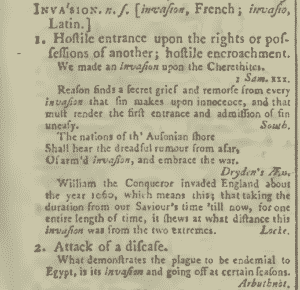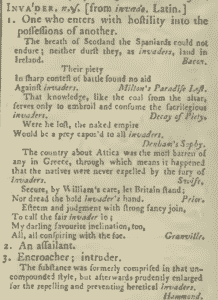Even by the middle of the 18th century, the English language lacked a widely-used set of standard definitions to English words.
While English dictionaries existed, those that did were widely considered deficient for a variety of reasons. Famous Scottish philosopher and historian, David Hume, complained that the English-speaking world possessed “no Dictionary of our Language, and scarce a tolerable Grammar.”
After a decade of intense work, famed English writer Samuel Johnson provided a remedy to these qualms through the publication of a two-volume dictionary. First released in 1755, his work had a profound effect on English literature and western civilization in general.
For almost two decades after its publication, Johnson’s Dictionary was still considered the seminal dictionary for the English-speaking world. This timeframe included that in which the American founders drafted and ratified legal documents, including the United States Constitution. As the contemporary gift to the historical scholar, Johnson’s work can be used to reach a deeper understanding of common terminology in its time of use.
With this background in mind, a firestorm of controversy has recently erupted over what is meant by the word “invasion” that appears in both Article I, Section 8, Clause 15, and Article IV, Section 4 of the Constitution. Respectively called the Militia Clause and the Guarantee Clause, these powers were meant to assure that the general government would protect the states from invasions.
However, the two clauses have recently been cited by those who support sending military forces to the southern border to restrict illegal immigration, with some going as far as to suggest that the president has a unilateral power to do so. It seems reasonable, then, to take a glance back and analyze what the American founders had in mind when they constructed the protection from invasion authority.
According to Jonson’s 1785 English dictionary, which was widely available as the Constitution was drafted, the term “invasion” is defined as follows:

The first definition – “hostile entrance upon the rights or possessions of another; hostile encroachment,” provides several specific examples for clarification. The first cites 1 Samuel 30 from the Bible. This chapter describes David’s conquest of the Amalekites. In this pursuit, David captured an escaped slave, who told him that his master had recently waged war upon a group of elite mercenaries known as the Cherethites. According to the Bible, the Cherethites were part of Israel’s army.
In the second case, exposition is given through an allusion to an invasion of the Ausonian shore, a reference to the southern and central regions of Italy. In this situation, the term is characterized by “arm’d invasion,” leading Ausonian nations to “embrace the war.”
The third case also references a specific military invasion that took place in 1066, where William the Conqueror raised an army with the intent of invading the English isles and overthrowing the Anglo-Saxon dynasty.
All three examples point to cases in which military forces were equipped with weaponry, fought behalf of a foreign power, and intended to commit physical violence against individuals in another country. Conversely, in no instance did the term refer to the migration of an individual, or even large groups, from one territory to another, where said individual(s) lacked intent to inflict military harm.
As to the second definition, “attack of a discase,” suggests a definition unconnected to military subjugation. However, with “discase” meaning to strip or undress, even this case relates to a deliberate attempt to cause physical harm to another person. Therefore, even with the argument that the word “invasion” has a broader application on this basis, it would still require one to hold that such invasion would include a physical attack rather than mere relocation.
Supporting this view is the definition of the term “invader” from the same dictionary:

As we can see, each of the examples cited in the first definition point to military actions, including an invasion of Scotland by Spanish invaders and a reference to invaders partaking in battle in Paradise Lost.
In addition, another example implies that the natives of Attica, a location in Greece, were never expelled because they had not faced the “fury of invaders.” Again, all examples suggest that military coercion was a key component of an invasion. Definition two – “an assailant” – pertains only to an individual that physically attacks another.
Outside of Samuel Johnson’s work, other dictionaries confirm this understanding. Nathan Bailey’s famous dictionary, which Johnson used as a primary source of information for his own, also bolsters this conception of the term.
According to the 1763 printing of the work, to invade was to “attack or set upon.” To “set upon” meant to make a sudden and unexpected physical attack, which is similar to how the phrase is widely used today. Similarly, another dictionary, printed in 1753 by John Bevis, records that to invade was to “enter by force” or to “seize and lay hold of.”
Regardless of one’s personal disposition on immigration and military policy, the founders’ understanding of “invasion” did not pertain to mere travel or migration from one country to another.
On the contrary, the most prominent English dictionary available, the most widely adopted legal dictionary in the American states, and other popular dictionaries of the era all held the term to mean the projection of a physical attack.
Consequently, the ability militarize United States borders to stop mass migration is not expressly granted through the originally ratified version of the Constitution.
- Thomas Paine: A Lifetime of Radicalism - December 23, 2023
- Thomas Paine’s Return to America - September 19, 2023
- 9 Mostly-Ignored Facts About Independence Day - July 3, 2023
